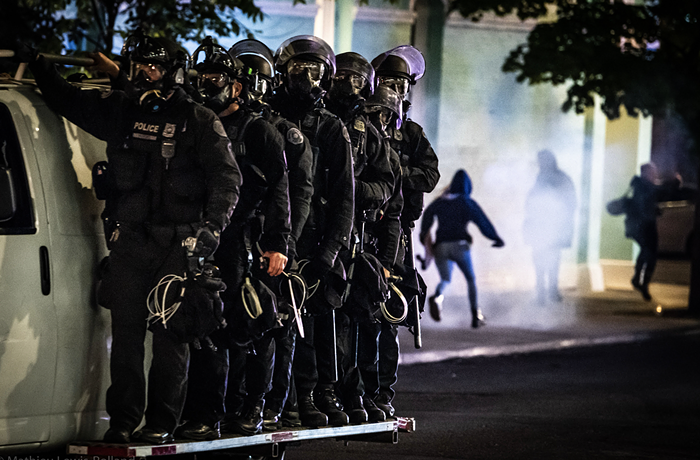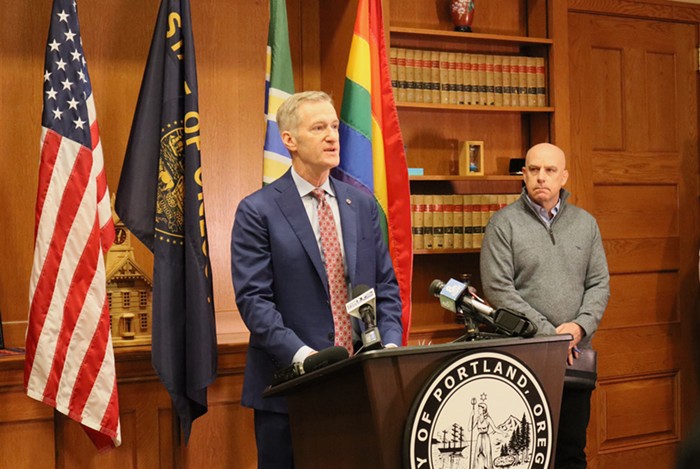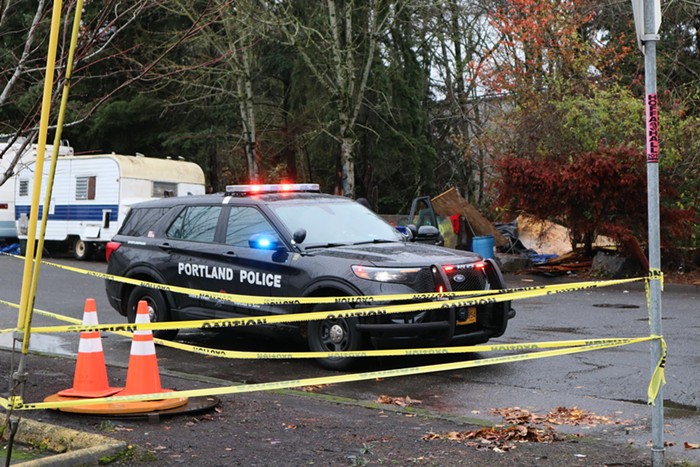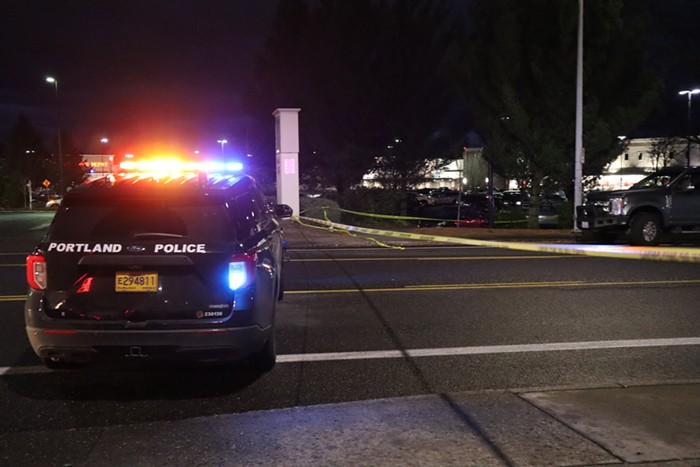
- Denis C. Theriault
- Commander Bob Day, of the Portland Police Bureau's training division, shows the clear difference between a regular (right) and a less-lethal shotgun.
"I want to be clear about this," the chief said during a press conference. "Using lethal rounds in less-lethal situations is a terrible mistake. We don't know how it occurred, but we know it should not happen. It is not a part of our training protocol."
Later, he reiterated the sentiment. "We've been in contact with his family. We feel very remorseful for his family. It was human error. We are humans. I know the officer feels terrible."
Adams, who ascended as police commissioner in May 2010, and named Reese as chief when he did, used similarly strong language.
"I'd like to apologize to the person who was injured by this mistake," Adams said. "I wish him a speedy recovery.... I praise good work by our bureau, but I also said we'd need to be more forthcoming about when we make mistakes."
There was little more information, however, about what led either to the mixup or the shooting—the fourth time a Portland officer fired a live round at someone, inadvertently or not, in 2011. Officer Dane Reister, a cop with 15 years on the force and a somewhat checkered history of rough behavior, was placed on administrative leave. The man hit was identified as William Kyle Monroe, someone cops said, as far as they knew today, with no previous criminal history in Portland.
Most of what was learned at the presser filled in some of the peripheral questions surrounding the incident. We learned that only four rounds were fired—with one ejected from the chamber unspent. Each of those rounds were buckshot rounds, containing nine pellets a piece. That means 36 pellets were fired toward Monroe as he tried to flee police, with only five hitting him, possibly indicating Reister was some distance away when he fired.
Monroe did have a knife, police said, but they wouldn't say at this point in their investigation whether he had ever brandished it at officers. Reese for the first time said Monroe was accused of harassing "5-year-olds" at a park near the shooting scene, a grassy field behind Caro Amico's, an Italian restaurant near SW Naito Parkway and Barbur. Officers also seemed to back away from descriptions of Monroe as intoxicated and said only that a 911 caller had accused him of "intimidating behavior," with no other details about said behavior given.
"We don't know" about whether Monroe was intoxicated, spokesman Sergeant Pete Simpson said after the presser. "The hospital may do blood tests."
Two other Central Precinct officers, Stuart Palmiter and Dan Halley, were on hand. So was an unidentified 18-year-old along for a ride-along with Palmiter.
The rest of the presser was devoted to a dissection of how the bureau normally tries to make sure these kinds of mistakes never happen.
Commander Bob Day, of the bureau's training division, brought examples of a less-lethal shotgun, covered in red plastic and marked with the words "LESS LETHAL," and a regular black shotgun. He also brought in the different rounds that can be loaded—red ones, which are lethal, and yellow and clear ones, which contain sock-like beanbag pouches. Unlike with new Taser shotguns being tested by the bureau, both kinds of shell will fire from either the red or black shotguns.
Only 220 officers out of nearly 1,000 are trained to use the bureau's 115 beanbag shotguns. Reister was first certified in 2002, officials said, and, like all officers who want to keep certified, needed to re-demonstrate his aptitude with the weapon every four months. The guns are kept at precinct headquarters and checked in and out by officers as needed. Reisters's shotgun, clearly marked as less-lethal, was the only shotgun of any type at the scene, Reese said.
Day said officers who use less-lethal ammo are trained not to mix it with regular ammo. They also are trained to make sure the gun is empty upon check out and to make the same inspection when they check it in. They are taught to load the shotguns in their police cruisers at the beginning of a shift.
Reese, who said the bureau was already looking at additional less-lethal training, chimed in to say that officers "should never mix the ammo. You should never carry live ammo when you're carrying a less-lethal shotgun."
"We're going to expedite that training now," he said, with Day adding that the new training would probably include a review of Thursday's shooting, part of a one-day, 10-hour training course.
Asked whether Reister could have seen or felt a difference between the two kinds of rounds after firing them once, let alone the next three times, Day said that was theoretically possible. The live rounds kick harder, and there's a difference between the spray of buckshot vs. the sock of the beanbag. But Day also said that in the fog of an encounter, detecting that difference isn't necessarily a "realistic expectation."
The investigation of Thursday's incident is ongoing, officials said. Detectives are trying to suss out more about what Monroe was doing at Lair Hill Park, what exactly happened between him and the officers, and also how the wrong ammo made its way into the less-lethal shotgun.
Recent updates by the bureau say Monroe was shot while trying to flee from officers and for not heeding their commands. The bureau is working with the city attorney's office, and also watching national court cases, to firm up its policies on when officers should use less-lethal weapons against someone who merely flees an officer.
Dan Handelman of Portland Copwatch says he can't remember the last time the Portland police brass issued so prompt and strong an apology—especially in light of what could be a lawsuit.
"Saying your sorry automatically admits there's something wrong," he said.
He also said Reister ought to be drug-tested, comparing him to a fork-lift operator that drops a pallet.
"In this case, something went really wrong," Handelman said.
Here's the cops' latest release.
Portland Police Detectives have been investigating the incident that occurred yesterday, June 30, 2011, that involved a Portland Police Officer deploying a less lethal beanbag shotgun, which inadvertently contained lethal rounds.The officer is identified as 15-year veteran Dane Reister, who is currently assigned to Central Precinct. It is now believed that Officer Reister fired 4 times and an additional round was ejected. Additional witness officers were Officer Stuart Palmiter, a 19-year veteran and Officer Dean Halley, a 25-year veteran. An 18-year-old ride-along was also with Officer Palmiter.
Officers came into contact with the subject, 20-year-old William Kyle Monroe, at 10:20 after responding to reports of a man possibly harassing children involved in a day camp at Lair Hill park. A later call to 9-1-1 reported the man had a pocket knife and was acting in a peculiar manner.
Officers located the suspect at Southwest Pennoyer and Naito Parkway. He fled on foot up an embankment toward Barbur Blvd. Officers then confronted the individual and at some point the application of the less lethal beanbag shotgun was deployed. It was only after the subject was hit that officers realized that lethal rounds were fired. Officers immediately rendered medical care and called for an ambulance. The subject is believed to have been hit by 5 pellets in the hip area and is in critical, but stable condition at an area hospital.
The Police Bureau began carrying less lethal beanbag shotguns in the mid-1990s. An incident like this has never occurred in the Portland Police Bureau prior to today. Training protocols require the officers who are certified in this weapon to visually inspect each round. Lethal rounds are red and blue and less lethal rounds are yellow and clear in color. Officers are required to also do a safety check and load the weapon at the beginning of their shift.
The involved officer, remains on paid administrative leave per Bureau policy. The investigation is continuing. Anyone with information about this incident asked to call Detective Rico Beniga at (503) 823-0457 or Detective Michele Michaels at (503) 823-0692.

















